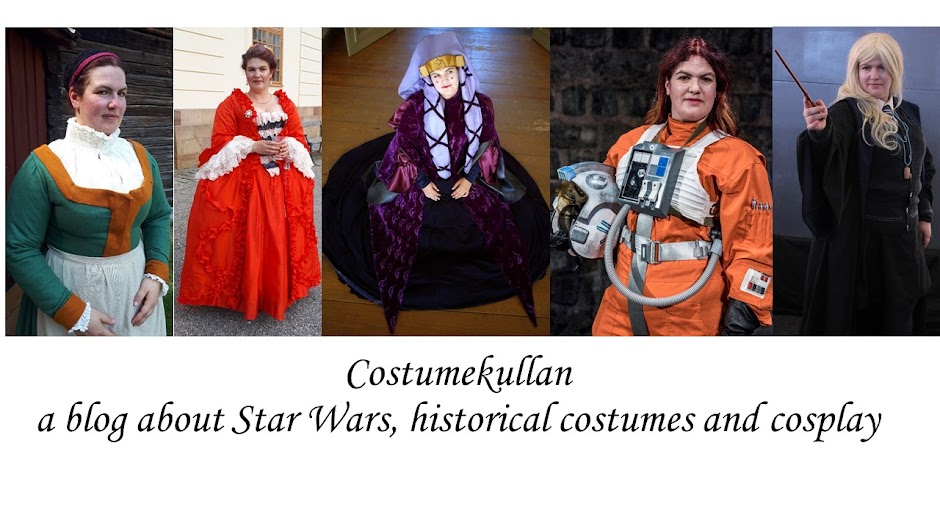know about this more than a month in advance I decided to make a more advanced gown this time. I also knew about a big 18th century masquerade that was going to take place in the autumn, and felt that this smaller event would be a good reason to try out a new pattern, before making a proper costume. I ordered Reconstructing History 822 and 6 meters of really cheap poly satin. I did the lining in some muslin that I found in my stash, and I first cut out the muslin before cutting the satin.
The pattern itself is one of the readily available ones. It's obviously inspired by the same gowns as Arnold has in Patterns of Fashion, so if you are more confident than me when it comes to scaling there is no need to buy this pattern.
One thing that is obvious is that the back of the gown to the right has a waist seam, something that isn't in the pattern. For this first trial version I decided to stay close to the pattern and used the "en fourreau"-styled back. There are a couple of issues with this pattern, but for this first version I decided to stay quite close to it. I't s also quite some time since I made it, but I think I only did some small adjustment at the sides seams, mainly taking it in. I possibly cut the neckline wider as well, since I felt that it was too demure for my taste.
One main problem with the pattern was the sleeves though. I don't know how they have been scaled, but they are huge. Thankfully I sewed them in muslin first, and eventhough I tried to ease and gathered the sleeves according to the instructions I ended up with something more like late 19th century leg-of-mutton sleeves than 18th century. I tweaked the pattern by pinning, drawing with pencil and cutting away at the shoulder head. You can see the picture where I've put the original sleeve under the new one that I managed to created.
Here you can also see when I have pinned both sleeves on to the bodice. Even with my tweaking of the pattern I still got quite a bulge at the back of the sleeve. After having done this pattern three times I've started to realize that I need to work more with the shape of the arm scye, but I didn't know that at this stage. An unfortunate side effect of the tweaking of the pattern is that the sleeve also got a lot shorter. It used to go below the elbow, now it ends just right at it. With this gown I could hide that by adding some flounces in the same material as the gown.
For the flounces I also used the pattern that was included, but I've gotten better result from some online tutorials on flounces on ruffles. Since this was a test dress I didn't hem the flounces but simply used my modern pinking shears. The trim around the neckline and down the front was a wide ribbon that I made by sewing a tube of fabric together and boxpleated. It's a bit too bulky, so if I want to make a box pleated trim in the future I want to either make tiny hems or use bought ribbon.
 Just before leaving for the event my pocket hoops broke though, and the damage was irreparable. I dug up my old "travel bustle" from my 1880's walking gown, adjusted some of the ribbons that held it in shape, and voilá I had a suitable 18th century bumpad. The thing with the "travel bustle" was that it was just made from soft materials, no boning, it's basically a stuffed pillow with some flounces over it, and that made it easily adjustable.
Just before leaving for the event my pocket hoops broke though, and the damage was irreparable. I dug up my old "travel bustle" from my 1880's walking gown, adjusted some of the ribbons that held it in shape, and voilá I had a suitable 18th century bumpad. The thing with the "travel bustle" was that it was just made from soft materials, no boning, it's basically a stuffed pillow with some flounces over it, and that made it easily adjustable.I reused the petticoat from the previous year, it didn't hang properly without the pocket hoops, but nothing that wasn't impossible to fix with some safety pins.

All in all I was pretty satisfied with my first attempt at with a robe anglaise. The problems that I had, mostly with the wrinkling were things I anticipated due to the quality of the fabric. It's nice and shiny, and I get more attention and comments in this one from people than when I wear my more accurate cotton anglaise.
I'll use this as my "the public want's a pretty and shiny dress"-gown.




No comments:
Post a Comment